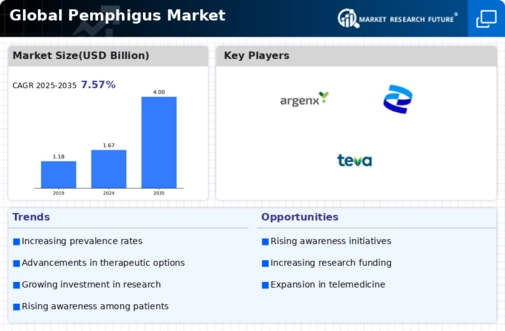Market Analysis
In-depth Analysis of Pemphigus Market Industry Landscape
The market dynamics of pemphigus are a reflection of the intricacies around this rare blistering autoimmune disease and how the healthcare industry has responded to these unique challenges. Pemphigus encompasses some rare diseases which leads to painful blisters on the skin and mucous membranes. The market is influenced by factors such as disease rarity, diagnostic methods, treatment options, ongoing research initiatives and economic considerations.
The rarity of pemphigus stands at the core of market dynamics. Because the incidence rates are low, there are some specific issues that affect the pemphigus market like lack of awareness, diagnosis and development of targeted treatments. Limited patient populations influence prioritization in R&D efforts as well as commercial viability for prospective treatments. Thus, due to its rarity, this market places significance on specialized care, joint researches and innovative therapeutic approaches.
Market dynamics depend significantly upon diagnostic methods since prompt and accurate diagnosis is crucial for management of any given disease. A combination of clinical evaluation, histopathology and immunological tests make up the diagnostics for pemphigus disorders. Direct immunofluorescence technique and enzyme-linked immunosorbent assay (ELISA) among other advancements in diagnosing techniques have led to precise identification and timely identification of cases with pemphigus hence improving accuracy rates while aligning closely with current trends in what constitutes new knowledge in acceptable professional practice within this field. Market responses to improved diagnostics accuracy results intensified treatment decisions making process helping both patients’ outcomes.
Immunosuppressive drugs are often used for treating pemphigus that control immune response causing blisters’ formation through medicating them with either: corticosteroids or immunosuppressants or biologics at times together depending on occurrence severity levels requiring various management stages so far practiced. Current searches aim at finding specifically targeted therapy for pemphigus by considering long-term side effects associated with using immunosuppressive drugs and enhancing the quality of life. Long-term research and development (R&D) processes are therefore expected to minimize side effects of therapies that are currently under development, leading to improved quality of life for individuals living with the disease.
Research plays a big role in determining how pemphigus market looks like. Collaboration between researchers, pharmaceutical companies and healthcare organizations support understanding behind this disorder as well as potential therapeutic interventions. The market can be influenced by scientific discoveries that could bring about new treatment options, close gaps in patient need related to pemphigus and offer more specific solutions tailored towards each individual person.
Market dynamics for pemphigus are affected by economic factors such as health care expenditure and insurance policies. In both patients’ perspective or health care systems, specialized care costs, cost of immunosuppressants medications and possible remedies for side effects pose serious challenges. That means because there is no way pharmaceutical companies or healthcare providers cannot consider economic considerations when developing or offering products or services related to pemphigus treatment.
Rare disease management in general contributes significantly towards the market dynamics of pemphigus. Regulatory frameworks, orphan drug designations and incentives for rare disease research shape the landscape for potential treatments. The market reacts to changing policies as well as initiatives targeted at addressing unique difficulties presented by rare diseases through collaborative efforts involving key stakeholders with interests in this market such as healthcare service provider and patients focusing on their needs accordingly.






Leave a Comment